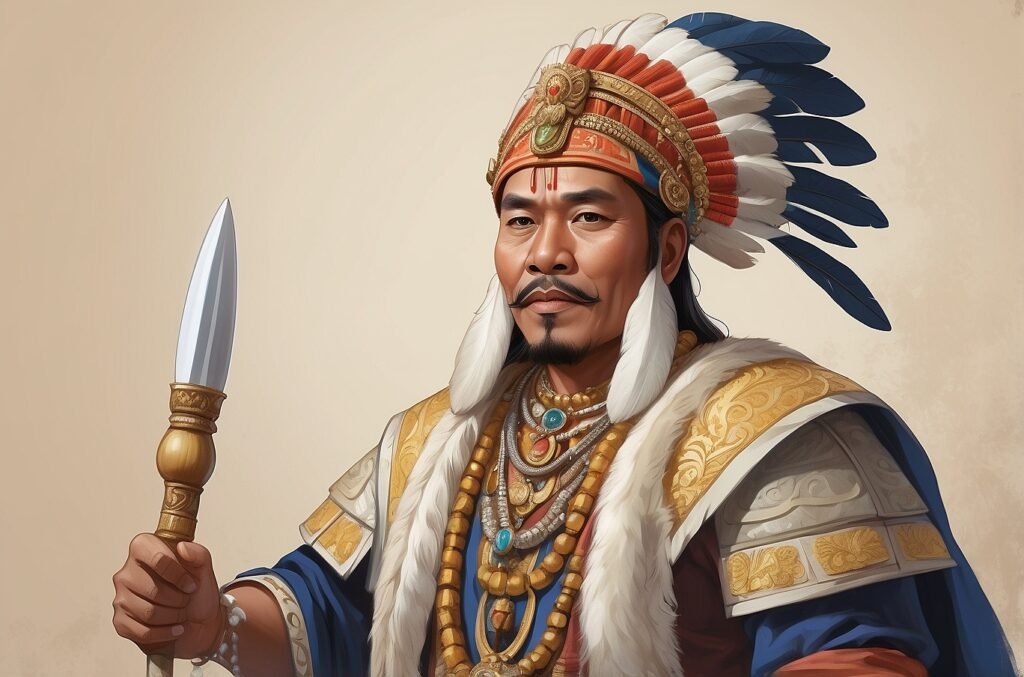In the annals of Southeast Asian history, few figures stand out as prominently as Queen Sima, the legendary ruler of the ancient kingdom of Cotabato. Her reign, which is believed to have occurred during the 7th century CE, left an indelible mark on the region’s political and cultural landscape. This blog post delves into the life, reign, and lasting legacy of Queen Sima, exploring her contributions to governance, justice, and the development of her kingdom. Through a careful examination of historical records and archaeological evidence, we will paint a comprehensive picture of this remarkable leader and her impact on the pre-colonial Philippines.
The Origins of Queen Sima
Historical Context
The 7th century CE was a time of great change and development in Southeast Asia. Maritime trade was flourishing, and various kingdoms were emerging as centers of power and culture. It was in this dynamic environment that Queen Sima rose to prominence in the kingdom of Cotabato, located on the island of Mindanao in the southern Philippines.
Early Life and Ascension to Power
While precise details about Queen Sima’s early life are scarce, historical records suggest that she was born into the ruling family of Cotabato. The kingdom, also known as Kutawato or Ma-i, was strategically positioned along important trade routes, making it a significant player in the region’s political and economic landscape. Queen Sima’s ascension to the throne is believed to have occurred through a combination of hereditary right and her demonstrated leadership abilities. Her reign marked a pivotal moment in the kingdom’s history, as she would go on to implement policies and reforms that would shape Cotabato for generations to come.
Queen Sima’s Reign and Governance
Leadership Style and Political Acumen
Queen Sima’s reign was characterized by her strong leadership and astute political maneuvering. She was known for her ability to balance the interests of various factions within her kingdom while maintaining a firm grip on power. Her governance style was marked by a combination of pragmatism and vision, as she sought to strengthen Cotabato’s position both internally and in relation to neighboring powers.
Economic Policies and Trade Relations
Under Queen Sima’s rule, Cotabato experienced significant economic growth and prosperity. She recognized the importance of trade and took steps to enhance the kingdom’s commercial relationships with other regions. Some of the key economic policies implemented during her reign included:
- Expansion of port facilities to accommodate more foreign traders
- Standardization of weights and measures to facilitate fair trade
- Encouragement of local craftsmanship and production of goods for export
- Establishment of diplomatic ties with neighboring kingdoms to secure favorable trade agreements
These policies helped to cement Cotabato’s position as a major trading hub in the region, attracting merchants from as far away as China, India, and the Middle East.
Military Achievements and Territorial Expansion
While Queen Sima is primarily remembered for her domestic achievements, she was also a capable military strategist. During her reign, Cotabato expanded its territorial influence, both through diplomatic means and, when necessary, military campaigns. The queen’s military prowess helped to secure the kingdom’s borders and protect its trade routes from potential threats.
The Famous Gold Chain Incident
A Test of Justice and Integrity
Perhaps the most well-known story associated with Queen Sima is the legendary “gold chain incident.” This tale, which has been passed down through generations, serves as a testament to the queen’s commitment to justice and the rule of law. The story goes as follows:
Queen Sima ordered a gold chain to be hung at a crossroads in the kingdom. The chain was left unguarded, serving as a test of the people’s honesty and respect for the law. For years, no one dared to touch or steal the chain, demonstrating the effectiveness of Queen Sima’s governance and the high moral standards she had instilled in her subjects.
Symbolic Significance
The gold chain incident, whether historical fact or allegorical legend, holds significant symbolic importance in understanding Queen Sima’s rule:
- It represents the queen’s emphasis on justice and moral integrity.
- It demonstrates the effectiveness of her governance in maintaining order and respect for the law.
- It serves as a powerful example of leadership by example, with the ruler setting high standards for her subjects to follow.
- It highlights the prosperity and security of the kingdom under Queen Sima’s rule, where valuable items could be left in public without fear of theft.
This story has become an integral part of Queen Sima’s legacy, often cited as an example of ideal governance and the power of moral leadership.
Queen Sima’s Legal and Judicial Reforms
Establishment of a Comprehensive Legal System
One of Queen Sima’s most significant contributions to Cotabato was the establishment of a comprehensive legal system. She recognized the importance of clear, fair, and enforceable laws in maintaining social order and promoting economic growth. Some key aspects of her legal reforms included:
- Codification of existing customary laws
- Introduction of new laws to address emerging social and economic issues
- Establishment of a hierarchical court system to handle disputes and administer justice
- Implementation of standardized punishments for various offenses
These reforms helped to create a more stable and predictable legal environment, which in turn fostered trust in the government and encouraged economic activity.
Emphasis on Fairness and Equality
Queen Sima’s legal system was notable for its emphasis on fairness and equality before the law. Historical records suggest that she insisted on impartial treatment regardless of social status or wealth. This commitment to justice is exemplified in the following table, which outlines some of the principles that guided her legal reforms:
| Principle | Description |
|---|---|
| Equality before the law | All subjects, regardless of rank or status, were subject to the same laws and punishments |
| Proportionality | Punishments were designed to fit the crime, avoiding excessive or arbitrary penalties |
| Transparency | Legal proceedings were conducted openly, with clear explanations of verdicts and sentences |
| Right to appeal | A system of appeals was established to allow for the review of judicial decisions |
| Protection of property rights | Clear laws were established to protect individual and communal property |
These principles helped to create a sense of fairness and accountability in Cotabato’s legal system, contributing to social stability and economic prosperity.
Cultural and Social Developments Under Queen Sima
Promotion of Education and the Arts
Queen Sima recognized the importance of education and cultural development in building a strong and prosperous kingdom. During her reign, she implemented several initiatives to promote learning and artistic expression:
- Establishment of schools and learning centers throughout the kingdom
- Patronage of artists, poets, and scholars
- Encouragement of cultural exchanges with neighboring kingdoms
- Preservation and documentation of local traditions and knowledge
These efforts not only elevated the cultural sophistication of Cotabato but also helped to create a more educated and skilled populace, contributing to the kingdom’s overall development.
Advancements in Agriculture and Infrastructure
Under Queen Sima’s rule, Cotabato saw significant advancements in agriculture and infrastructure. The queen recognized the importance of a strong agricultural base and efficient infrastructure in supporting the kingdom’s growing population and expanding trade networks. Some of the key developments in these areas included:
- Introduction of new farming techniques and crop varieties
- Construction of irrigation systems to improve agricultural productivity
- Development of road networks to facilitate internal trade and communication
- Expansion and improvement of port facilities to accommodate increased maritime trade
These improvements helped to boost Cotabato’s economic output and improve the quality of life for its inhabitants.
Queen Sima’s Diplomatic Relations and Foreign Policy
Establishing Alliances and Trade Partnerships
Queen Sima was known for her diplomatic acumen and her ability to forge beneficial relationships with neighboring kingdoms and distant powers. Her foreign policy was characterized by a combination of strategic alliances and carefully negotiated trade agreements. Some of the key aspects of her diplomatic efforts included:
- Establishing formal diplomatic relations with major regional powers
- Negotiating favorable trade agreements with key partners
- Participating in regional alliances to maintain balance of power
- Hosting foreign dignitaries and merchants to strengthen international ties
These diplomatic initiatives helped to enhance Cotabato’s prestige and influence in the region, while also securing economic benefits for the kingdom.
Cultural Exchange and Knowledge Transfer
Queen Sima’s reign was marked by a period of increased cultural exchange and knowledge transfer between Cotabato and other civilizations. She encouraged the flow of ideas, technologies, and cultural practices, recognizing their potential to enrich her kingdom. Some examples of this cultural exchange include:
- Adoption of advanced agricultural techniques from neighboring kingdoms
- Incorporation of foreign architectural styles in public buildings and monuments
- Exchange of scholarly works and religious texts with other centers of learning
- Assimilation of foreign artistic styles and motifs into local crafts and arts
This openness to foreign influences contributed to Cotabato’s cultural diversity and intellectual vibrancy, setting the stage for further developments in subsequent generations.
The Legacy of Queen Sima
Impact on Cotabato and the Region
Queen Sima’s reign left a lasting impact on Cotabato and the surrounding region. Her governance style, legal reforms, and economic policies set a standard for subsequent rulers to follow. The prosperity and stability achieved during her reign helped to establish Cotabato as a significant power in the pre-colonial Philippines, influencing the political and cultural landscape of the region for centuries to come.
Influence on Later Generations
The legacy of Queen Sima extended far beyond her immediate reign, influencing later generations of rulers and thinkers in the Philippines and Southeast Asia. Her emphasis on justice, good governance, and cultural development served as a model for subsequent leaders. The story of the gold chain, in particular, became a powerful symbol of ideal leadership and the importance of moral integrity in governance.
Archaeological Evidence and Historical Records
While much of what we know about Queen Sima comes from oral traditions and later historical accounts, archaeological evidence has helped to corroborate some aspects of her reign. Excavations in the Cotabato region have uncovered artifacts that point to a period of prosperity and cultural sophistication during the 7th century CE, aligning with the timeframe of Queen Sima’s rule. These findings include:
- Remnants of advanced irrigation systems
- Traces of fortified settlements and public buildings
- Trade goods from distant lands, indicating extensive commercial networks
- Inscriptions and artistic works that reflect a developed cultural tradition
While these archaeological discoveries do not provide direct evidence of Queen Sima herself, they support the historical narrative of a well-governed and prosperous kingdom during her purported reign.
Conclusion
Queen Sima of Cotabato stands as a remarkable figure in the history of Southeast Asia, embodying the ideals of just governance, economic prosperity, and cultural development. Her reign, characterized by legal reforms, diplomatic acumen, and a commitment to moral leadership, left an indelible mark on the kingdom of Cotabato and the wider region. The legendary gold chain incident serves as a powerful symbol of her emphasis on justice and integrity, while her economic and cultural policies laid the foundation for Cotabato’s emergence as a significant regional power.
As we reflect on Queen Sima’s legacy, we are reminded of the enduring impact that visionary leadership can have on a society. Her story continues to inspire and inform discussions on governance, justice, and cultural development in the Philippines and beyond. While the full extent of her historical reality may remain subject to debate, the principles and ideals associated with Queen Sima’s reign continue to resonate with contemporary audiences, offering valuable insights into the qualities of effective and just leadership.
Disclaimer: This blog post is based on available historical records, archaeological evidence, and scholarly interpretations. While every effort has been made to ensure accuracy, some details about Queen Sima’s life and reign remain subject to historical debate. Readers are encouraged to consult primary sources and academic works for further information. If you notice any inaccuracies in this post, please report them so we can correct them promptly.




